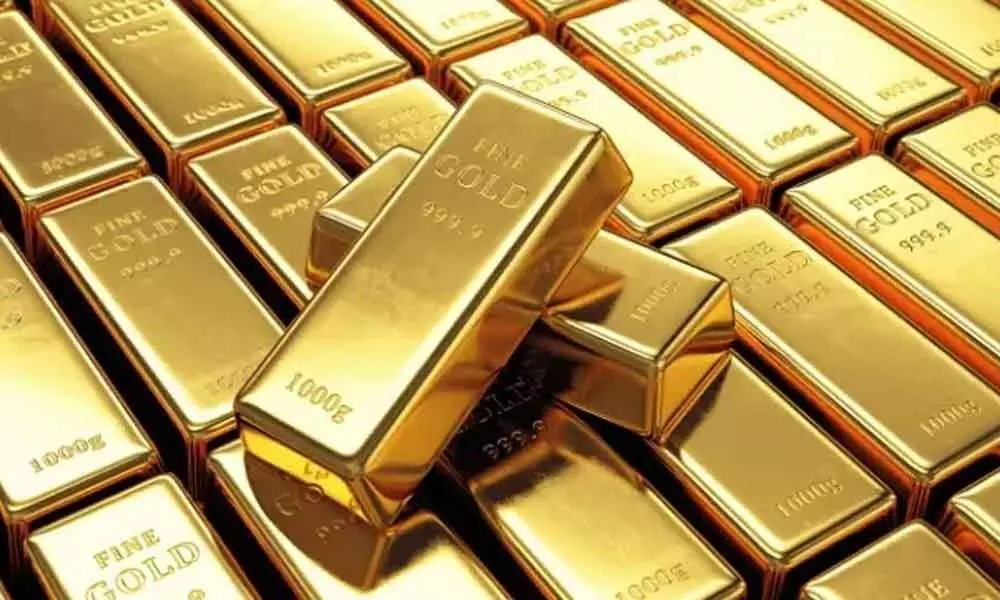Live
- Gentle in manner, resolute in convictions: Sonia Gandhi pens emotional note for Dr. Manmohan Singh
- 2024: A landmark year for India's defence achievements and breakthroughs
- 2025 Horoscopes: Insights and Guidance by Pt. Umesh Chandra Pant
- Osamu Suzuki was a legendary figure in global auto industry: PM Modi
- “AMOEBA”: Celebrating the Journey of Telugu Entrepreneur Sri Motaparti Siva Rama Vara Prasad
- Sachin Khedekar recites a poem from director Feroz Abbas Khan’s powerful new play, ‘Hind 1957’
- NABL-QCI appoints Dr. Sandip Shah as chairperson
- Centre transfers Rs 2.23 lakh crore for 1,206 schemes under Direct Benefit Transfer
- BGT 2024-25: Watching Konstas bat reminds me of Symonds, says Hayden
- 75 iconic lighthouses in India saw more than 10 lakh visitors till September
Just In

The yellow metal price will reach its peak on continued geopolitical tremor, economic woes and rupee volatility
Mumbai: Always a pricey possession, gold is set to remain pricier in the New Year too as continuing geopolitical tremors, economic woes and rupee volatility are expected to push the yellow metal even to Rs 45,000 for 10 gram.
Thanks to various government policies and soaring stock market, gold witnessed periodic as well as steep price fluctuations in 2019, with bias towards the higher side in the second half of this year.
Data from the World Gold Council shows that 14 central banks, including the RBI, have reportedly added more than one tonne to their reserve.
"As we look to 2020, we believe investors will face increasing geopolitical concerns, while many pre-existing ones will be pushed back rather than being resolved.
In addition, the low level of interest rates worldwide will keep stock prices high and valuations at extreme levels, on the verge of peaking out.
Therefore, we believe there are reasons for higher levels of safe-haven assets like gold," Commtrendz Research Director Gnanasekar Thiagarajan said.
From US-China trade turmoil to conflicts in the Middle East, geopolitical issues are galore for the global markets which might also await cues from the US presidential polls towards end of 2020.
The potential medium-term target lies at Rs 41,000-41,500 per 10 gram at MCX ($1,640-1,650). Further, the level could rise to Rs 44,500-45,000 ($1,795-1,800) in case there are new developments on the global front that could dent risk appetite, Thiagarajan said.
World Gold Council Managing Director (India) Somasundaram P R said local currency prices in almost all markets, including rupee, breached previous life-time highs, leading to muted consumer demand across markets.
"Indian demand also lost significant momentum in Q3, and though Q4 saw a revival with its traditional wedding and festival season, overall demand for the full year is expected to be at the lower end of 700-750 tonne.
ETF (Exchange Traded Fund) demand in the US and Europe, and central bank buying across nations, however, continue to be strong," he noted.
According to him, the Reserve Bank of India (RBI) was one of the main buyers of gold in 2019, increasing its reserves by over 60 tonne. China and Russia have been the biggest buyers of gold till now.
Besides, countries like India, Turkey, Poland and Kazakhstan have also joined the bandwagon in purchasing the yellow metal.
In the first half of this year, gold was relatively more attractive for consumers as the price ruled at around Rs 31,500-32,000 for every 10 gram. However, in July demand began to become weak as prices started to climb.
Depreciation of Rupee along with the government increasing customs duty by 2.5 percentage points during Budget to 12.5 per cent from 10 per cent made it even more costly in the domestic market.
In 2019, gold peaked at $1,557 an ounce and Rs 39,900 per 10 gram.
All India Gem & Jewellery Domestic Council (GJC) Chairman Anantha Padmanaban said that from consumer perspective, 2019 was a mixed year as the first half was very good in terms of demand.
However, since July as the gold prices moved up, the demand dwindled as jewellery became a very costly affair after the added burden of customs duty and Goods and Services Tax (GST), he noted.
He also pointed out that untimely rains that damaged crops further attributed to the negative sentiment as around 70 per cent of the demand in India is from rural areas.
India Bullion and Jewellers Association (IBJA) National President Prithviraj Kothari opined that gold price trend is rising and the market would soon reach newer high ideally in the next 2-3 years.
"Also, the global economic slowdown, liquidity crisis in India and depreciation of the rupee against the $ which has now reached Rs 71, and is likely to reach Rs 72 soon, will support the gold market.
I am positive that in 2020, the gold prices will be in the range of Rs 38,000 on the downside and Rs 42,000 on the upside," he added.
Motilal Oswal Financial Services VP (Commodity Research) Navneet Damani said that in the short term, strong support for gold is placed in the range of Rs 37,100-36,900 levels on MCX. On the higher side gold price is likely to move higher towards Rs 39,900 levels followed by Rs 41,500, he added.
Among other measures, mandatory hallmarking of gold would be a positive in making the gold market more organised, Somasundaram said.
Mandatory hallmarking would come into effect from January 15, 2020, with a one-year transition period for traders to sell existing inventories.
Experts also expect more policy measures next year to bring in more transparency in terms of gold as an asset class.

© 2024 Hyderabad Media House Limited/The Hans India. All rights reserved. Powered by hocalwire.com







